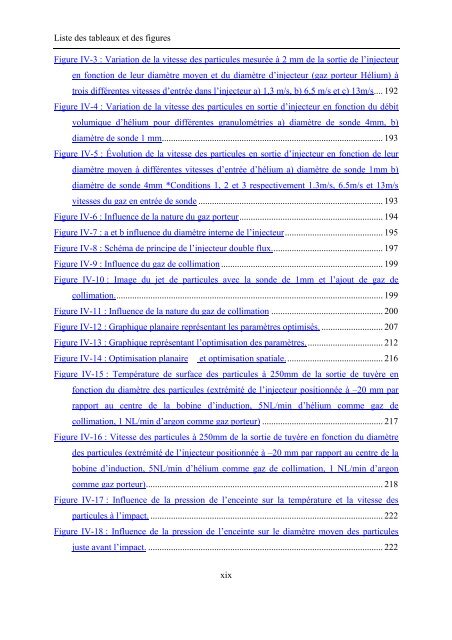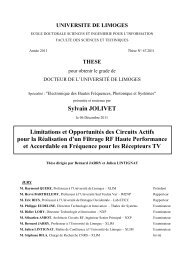Texte intégral en version PDF - Epublications - Université de Limoges
Texte intégral en version PDF - Epublications - Université de Limoges
Texte intégral en version PDF - Epublications - Université de Limoges
Create successful ePaper yourself
Turn your PDF publications into a flip-book with our unique Google optimized e-Paper software.
Liste <strong>de</strong>s tableaux et <strong>de</strong>s figures<br />
Figure IV-3 : Variation <strong>de</strong> la vitesse <strong>de</strong>s particules mesurée à 2 mm <strong>de</strong> la sortie <strong>de</strong> l’injecteur<br />
<strong>en</strong> fonction <strong>de</strong> leur diamètre moy<strong>en</strong> et du diamètre d’injecteur (gaz porteur Hélium) à<br />
trois différ<strong>en</strong>tes vitesses d’<strong>en</strong>trée dans l’injecteur a) 1,3 m/s, b) 6,5 m/s et c) 13m/s.... 192<br />
Figure IV-4 : Variation <strong>de</strong> la vitesse <strong>de</strong>s particules <strong>en</strong> sortie d’injecteur <strong>en</strong> fonction du débit<br />
volumique d’hélium pour différ<strong>en</strong>tes granulométries a) diamètre <strong>de</strong> son<strong>de</strong> 4mm, b)<br />
diamètre <strong>de</strong> son<strong>de</strong> 1 mm................................................................................................. 193<br />
Figure IV-5 : Évolution <strong>de</strong> la vitesse <strong>de</strong>s particules <strong>en</strong> sortie d’injecteur <strong>en</strong> fonction <strong>de</strong> leur<br />
diamètre moy<strong>en</strong> à différ<strong>en</strong>tes vitesses d’<strong>en</strong>trée d’hélium a) diamètre <strong>de</strong> son<strong>de</strong> 1mm b)<br />
diamètre <strong>de</strong> son<strong>de</strong> 4mm *Conditions 1, 2 et 3 respectivem<strong>en</strong>t 1.3m/s, 6.5m/s et 13m/s<br />
vitesses du gaz <strong>en</strong> <strong>en</strong>trée <strong>de</strong> son<strong>de</strong> ................................................................................. 193<br />
Figure IV-6 : Influ<strong>en</strong>ce <strong>de</strong> la nature du gaz porteur............................................................... 194<br />
Figure IV-7 : a et b influ<strong>en</strong>ce du diamètre interne <strong>de</strong> l’injecteur........................................... 195<br />
Figure IV-8 : Schéma <strong>de</strong> principe <strong>de</strong> l’injecteur double flux................................................. 197<br />
Figure IV-9 : Influ<strong>en</strong>ce du gaz <strong>de</strong> collimation ....................................................................... 199<br />
Figure IV-10 : Image du jet <strong>de</strong> particules avec la son<strong>de</strong> <strong>de</strong> 1mm et l’ajout <strong>de</strong> gaz <strong>de</strong><br />
collimation...................................................................................................................... 199<br />
Figure IV-11 : Influ<strong>en</strong>ce <strong>de</strong> la nature du gaz <strong>de</strong> collimation ................................................. 200<br />
Figure IV-12 : Graphique planaire représ<strong>en</strong>tant les paramètres optimisés. ........................... 207<br />
Figure IV-13 : Graphique représ<strong>en</strong>tant l’optimisation <strong>de</strong>s paramètres.................................. 212<br />
Figure IV-14 : Optimisation planaire et optimisation spatiale........................................... 216<br />
Figure IV-15 : Température <strong>de</strong> surface <strong>de</strong>s particules à 250mm <strong>de</strong> la sortie <strong>de</strong> tuyère <strong>en</strong><br />
fonction du diamètre <strong>de</strong>s particules (extrémité <strong>de</strong> l’injecteur positionnée à –20 mm par<br />
rapport au c<strong>en</strong>tre <strong>de</strong> la bobine d’induction, 5NL/min d’hélium comme gaz <strong>de</strong><br />
collimation, 1 NL/min d’argon comme gaz porteur) ..................................................... 217<br />
Figure IV-16 : Vitesse <strong>de</strong>s particules à 250mm <strong>de</strong> la sortie <strong>de</strong> tuyère <strong>en</strong> fonction du diamètre<br />
<strong>de</strong>s particules (extrémité <strong>de</strong> l’injecteur positionnée à –20 mm par rapport au c<strong>en</strong>tre <strong>de</strong> la<br />
bobine d’induction, 5NL/min d’hélium comme gaz <strong>de</strong> collimation, 1 NL/min d’argon<br />
comme gaz porteur)........................................................................................................ 218<br />
Figure IV-17 : Influ<strong>en</strong>ce <strong>de</strong> la pression <strong>de</strong> l’<strong>en</strong>ceinte sur la température et la vitesse <strong>de</strong>s<br />
particules à l’impact. ...................................................................................................... 222<br />
Figure IV-18 : Influ<strong>en</strong>ce <strong>de</strong> la pression <strong>de</strong> l’<strong>en</strong>ceinte sur le diamètre moy<strong>en</strong> <strong>de</strong>s particules<br />
juste avant l’impact. ....................................................................................................... 222<br />
xix
















